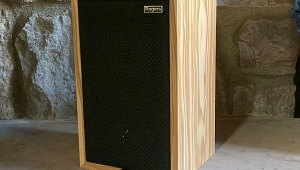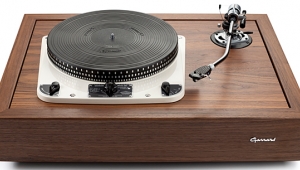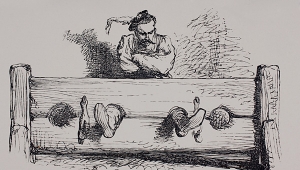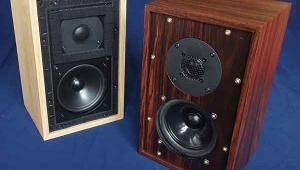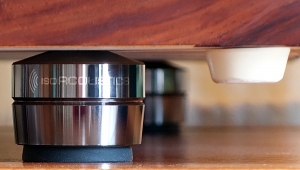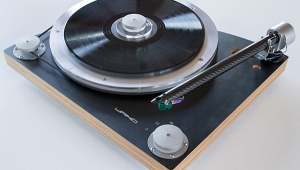| Columns Retired Columns & Blogs |
Listening #55
When audio designer Ken Shindo was a little boy, his father kept an enormous collection of 78rpm records in their home in Tokyo. During the final days of World War II, the Japanese authorities did their best to evacuate the city, but the elder Shindo was steadfast: He refused to leave, for fear that the records would be gone when he returned.
Footnote 1: Shindo Laboratory. Web: www.shindo-laboratory.co.jp. US distributor: Tone Imports LLC. Tel: (646) 425-7800. Web: www.toneimports.com.
 The evacuation was inevitable, and the worst came to pass: Virtually all of the family's belongings were destroyed. Yet by the end of 1947, according to one of Ken's sisters, the record collection had been replaced entirely—and a fine new music system became the center of family life.
The evacuation was inevitable, and the worst came to pass: Virtually all of the family's belongings were destroyed. Yet by the end of 1947, according to one of Ken's sisters, the record collection had been replaced entirely—and a fine new music system became the center of family life.
It isn't hard to see a parallel between the elder Shindo's efforts during those postwar years and those of his son in the here and now: Ken Shindo has worked steadily and quietly to become one of the foremost conservators of early audio technologies—and, by definition, of recorded music itself.
As I described in last month's column, Ken Shindo and Shindo Laboratory make amplifiers and other domestic audio gear with one goal in mind: to re-create the true tone of music, in every sense, and in accordance with his own artistic vision—or, as he describes it, the music mind (footnote 1). The products of Shindo-san the designer draw heavily on the talents of Shindo-san the collector, in that he makes generous use of vintage parts: things from a day and age when the scarcity and expense of component parts imposed on the designer a certain grave simplicity and a concomitant lack of electronic filigree.
The amplifiers and preamplifiers manufactured by Shindo Laboratory all use tubes instead of transistors. I resisted saying of course, because Ken Shindo takes nothing for granted. To him, the choice of a certain part or design innovation has nothing to do with accepted wisdom, and everything to do with listening and making his own decisions. Shindo-san has devoted his professional life to learning the sounds of various tubes, resistors, capacitors, wires, jacks, switches, and enclosure materials.
And transformers—definitely transformers. To appreciate Shindo's work is to respect and revere the otherwise lost art of transformer design. If you're like me, your sense of technological wonder can be recharged in an instant by thinking that a choice of shellac or wax—the work of bugs and bees, respectively—can have a material effect on the sound of reproduced music, even in the 21st century. But Peter Walker knew it. So did Norman Crowhurst, Leo Fender, and Hiroyasu Kondo. And so does Ken Shindo (footnote 2).
Shindo Laboratory Montille power amplifier
The 15Wpc push-pull Montille amplifier ($3995, footnote 3) is Shindo Laboratory's least expensive monument to the art of the transformer. It's a determined-looking amp that measures only 10" wide by 11.5" deep by 7" tall with its steel tube cage in place. (While I loved the retro styling, the Montille sounded very slightly better with its cage removed.) As with Shindo's other amps and preamps, the Montille comes in one color only: green—like the bottles of wine his designs are mostly named for.

Like all Shindo amplifiers, the Montille has an outer front panel of clear acrylic, on which the product name and company logo are silk-screened in gold. More interesting—and more useful—is another front-panel feature shared by all Shindo amplifiers: individual input-level controls for the left and right channels. (Shindo's mono amps have one each, of course.) In Shindo-san's opinion, all preamp volume controls sound their best within a certain range, throughout which the two channels track each other most accurately—so he provides gain adjustment at the amp to compensate for variations in speaker efficiency, room size, and listening-level preference, and thus to optimize the manner in which the preamp and amp work together. (Providing individual left- and right-channel level controls on the amp also makes up for the absence of a balance control on the preamp; as to the absence of a mono switch, read on.)
I used one of my many Audio Research screwdrivers to remove the Montille's bottom cover, and found the same superb craftsmanship that characterized the Shindo Aurieges preamplifier: All chassis surfaces were painted and polished, inside and out, and all of the wiring was neatly done by hand, point to point. And the Montille was built with a good many vintage American parts, such as Allen-Bradley carbon-composition resistors and Sprague Orange Drop and Black Beauty capacitors.
The power supply, which I gather has changed somewhat since the Montille was introduced (my sample was serial number 48), is a model of ingenuity. A high-voltage secondary winding on the power transformer leads to a full-wave rectifier built with modern diodes, leading in turn to individual smoothing chokes for the left and right channels. That secondary winding is also center-tapped—and that goes to the cathode of a Siemens EY88 "booster diode" tube. I was mystified until my friend Neal Newman suggested, and my digital voltmeter confirmed, that the purpose of the tube is to let the rail voltage increase gradually from 0 to 350, thus avoiding the punishment of applying full power all at once—which would be unwise in an amplifier built from vintage parts and rare tubes.
From the Montille's input-level pot the music signal goes to the grid of the triode half of a 6AW8A dual tube; that half of the 6AW8A appears to be used for gain, while the pentode half is used for phase inversion—although the precise nature of the circuit escapes my understanding. Also apparently, the screen grids of the Telefunken EL84 power pentodes are connected to the output-transformer primaries, suggesting that the class-A/B Montille uses a distributed-load (ie, Ultralinear, or some variation thereof) output stage. A single pair of speaker connectors, labeled 8 ohms, is provided per channel, although a pair of sealed and bundled wires inside the amp made me wonder if additional secondaries are available for alternative loads.
In some ways, the Montille is the most impressive of Ken Shindo's designs. It isn't necessarily the best-sounding amplifier from Shindo Laboratory—although I can't imagine a music enthusiast who wouldn't fall in love with the Montille's muscular but silky-smooth presentation and its eminently believable reproduction of instrumental and vocal timbres. More important, the Montille gets all of the basics of music-making just as right as can be: tempo, flow, momentum, and other qualities that define music as an art form in which time is the single most crucial component. The Montille also captures pitches and pitch relationships, and a frequency-related quality I can describe only as the sweetness of each individual note.
Some perspective: When I first settled in with the seriously good Lamm ML2.1 monoblock amplifiers (Stereophile's October 2004 issue), I was astounded. The Lamm amps did two things I'd never heard anywhere before: They stripped and scraped a tremendous amount of gunk from the sounds of voices and instruments—gunk I'd never suspected was there in the first place—and they ardently followed the lines those voices and instruments made, against the constant of time.
The humblest Shindo amplifier doesn't scrape away quite as much gunk; the 15Wpc, single-chassis stereo Montille is not as transparent, and it doesn't pull solo sounds out of the mix as neatly as the Lamms—or other single-ended amps, such as the Fi 2A3, for that matter. But the Montille follows the music with even more crazy ardor, bending around each melodic curlicue and phrase toward its temporal conclusion. Its finish line.
An example of what the Montille does best: Early in the title song from Larry Sparks's John Deere Tractor (LP, Rebel REB-1588), there's a wonderful moment when the fiddle in the left channel and the dobro in the right channel—both of which had been improvising up to this point—converge on the same melodic line. The Montille nails the excitement of that moment, and reveals just how smoothly and rightly the lines flow together. The only other amp I've tried that matches the Montille's performance in that regard—its ability to actually re-create music instead of just sound—was another Shindo model.
Another example: Play Clifford Curzon and George Szell's recording of Brahms' Piano Concerto 1 on the system of your choice, and try to picture Curzon's hands moving over the keys while you're listening. Now repeat the piece through even the least expensive Shindo combination—the Aurieges preamplifier I wrote about last month ($3895) and the Montille amplifier—and try once again to imagine a human being exerting force on the keys. If your experience parallels mine, there's no comparison.
The Montille could also rock when it wanted to. On "Twistin' the Night Away" by the pre-sellout Rod Stewart, from Never a Dull Moment (LP, Mercury SRM 1646), the force with which Micky Waller whaps his snare drum was delightfully obvious, and the perfectly sloppy electric bass filled the room just the way it does in real life. And when the tambourine came in, the timing was so perfect, and the sound so lifelike, that it caught me off guard. It was believable—and a hell of a lot of fun.
The only thing the Shindo Montille didn't do well was to drive my Quad ESL loudspeakers: The combination wasn't awful, but it was far from optimal—possibly because Shindo's amps don't use as much feedback as the Quads seem to enjoy. Whatever the reason, my Quad speakers still sound best with my old Quad amplifiers—while the Montille was consistently impressive with the very efficient Audio Note AN-E Lexus Signature loudspeakers.
Footnote 1: Shindo Laboratory. Web: www.shindo-laboratory.co.jp. US distributor: Tone Imports LLC. Tel: (646) 425-7800. Web: www.toneimports.com.
Footnote 2: Even John Atkinson—who, after 35 years as an audiophile, remains unimpressed with the snakes and idols of tube worship—has been moved to superlatives by the occasional good trannie, as noted in his technical observations of the Lamm ML2.1 monoblocks and the Cayin A-300B stereo integrated amplifier.
Footnote 3: Just as the June issue went to press, Shindo Laboratory announced that the price of the Montille had risen slightly from the original $3895, to accommodate the increasing scarcity of certain vintage parts.
- Log in or register to post comments


